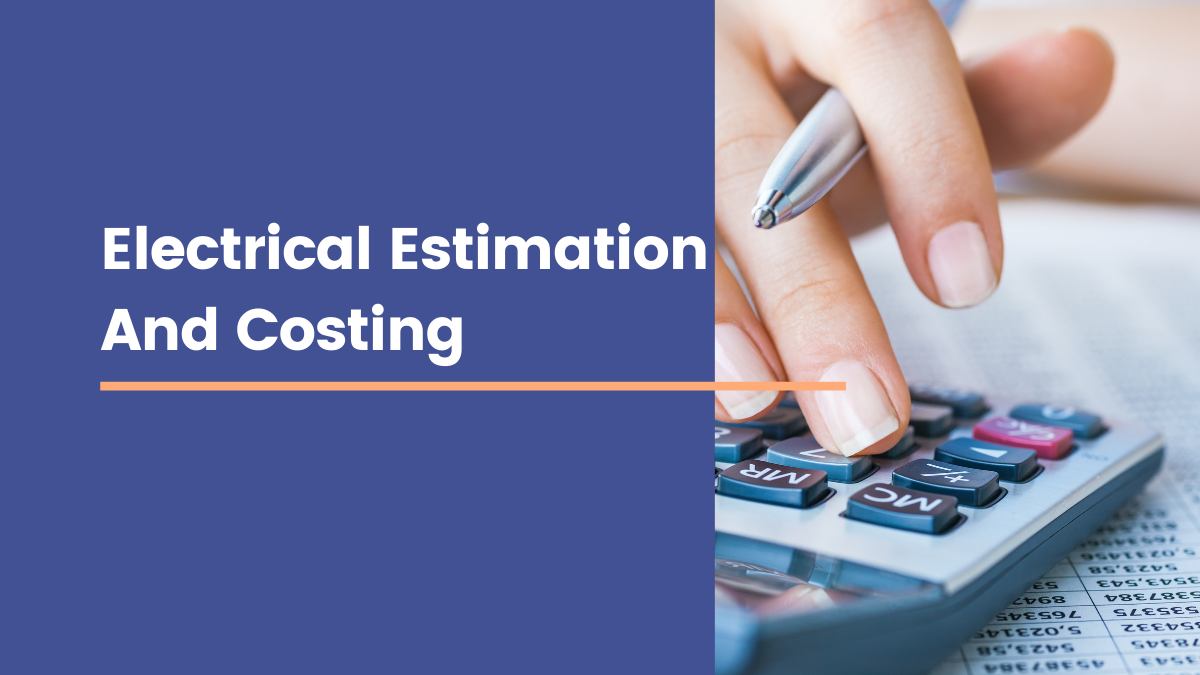
Have you ever wondered how much it costs to install electricity in your home, office or any other building? Or have you ever been curious about the process behind estimating electrical projects? If so, then this post is for you.
Electrical estimation and costing are crucial aspects of any construction project involving electrical work. They help determine the anticipated cost of materials, labor, and other expenses related to installing and maintaining an efficient electrical system.
I will dive deep into the world of electrical estimation and costing, exploring its importance, key components, best practices and more. So buckle up as we take a ride through the fascinating world of electrifying numbers!
Overview of Electrical Estimation and Costing
Estimating electrical costs is vital in construction. It involves calculating the expected costs of electrical parts and systems. Electrical estimating includes tasks like quantity takeoffs and cost analysis. It also includes labor estimations and budget projections, which are specific to electrical work within a project.
By utilising specialised software, industry knowledge, and expertise, electrical estimating professionals can accurately forecast the expenses related to wiring, fixtures, equipment, and compliance with electrical codes and standards.
The goal of electrical estimating is to provide accurate cost assessments. These assessments help project stakeholders plan budgets, make informed choices, and ensure successful electrical installations in construction projects.
Challenges in Electrical Estimation and Costing Processes
Accurate estimates are crucial in electrical projects. They ensure project success, control costs, and maintain quality standards during construction. The importance of accurate estimation in electrical projects can be summarized as follows:
Budget Planning:
Accurate estimates serve as the foundation for developing realistic budgets for electrical work within construction projects. Reliable cost projections help stakeholders allocate resources effectively, avoid budget overruns, and ensure financial stability during project execution.
Resource Allocation:
Precise estimations enable efficient resource allocation by specifying the quantities of materials, equipment, and labor required for electrical installations. Proper resource planning based on accurate estimates minimizes wastage, optimizes material procurement, and enhances project efficiency.
Bid Preparation:
Accurate electrical estimates are essential for preparing competitive bids, securing contracts, and winning projects in a competitive market. Reliable cost estimates demonstrate professionalism, credibility, and transparency, positioning contractors favorably during the bidding process.
Project Scheduling:
Realistic estimates guide project scheduling by outlining the duration and sequencing of electrical tasks within the overall construction timeline. Accurate estimations help prevent delays, streamline workflow coordination, and ensure the timely completion of electrical work without disrupting project milestones.
Quality Assurance:
Accurate estimations contribute to maintaining quality standards in electrical projects by specifying the necessary materials, equipment, and installation methods required for compliance with safety regulations and industry best practices.
Client Expectations:
Reliable estimates instil confidence in clients by demonstrating transparency, professionalism, and attention to detail in project planning. Accurate cost projections help manage client expectations, build trust, and foster positive relationships based on clear communication and accountability.
Risk Management:
Accurate estimations support effective risk management by identifying potential cost variations, contingencies, and uncertainties associated with electrical work. Comprehensive estimates enable stakeholders to anticipate and mitigate risks proactively, reducing the likelihood of financial surprises or project disruptions.
Legal Compliance:
Accurate electrical estimates ensure compliance with regulatory requirements, building codes, and safety standards governing electrical installations. By adhering to statutory obligations and industry guidelines, precise estimations help avoid non-compliance penalties, rectification costs, and legal disputes.
Project Success:
Estimation is key to project success in electrical construction. It affects profitability, client satisfaction, efficiency, and project outcomes.
Strategies for Controlling Costs in Electrical Projects
Implementing effective cost control strategies can help mitigate financial risks, optimise resource utilisation, and improve overall project performance. Here are seven strategies for controlling costs in electrical projects:
-
Thorough project planning, including a comprehensive scope of work, detailed schedules, and accurate estimates, is crucial for cost control. Establishing clear project objectives, defining deliverables, and identifying potential cost drivers from the outset help minimise budget deviations.
-
Implement a robust cost monitoring system to track expenses, compare actual costs against budgeted amounts, and identify variances early on. Regularly reviewing financial data, analysing cost trends, and conducting frequent cost evaluations enable proactive cost management.
-
Incorporate value engineering principles to optimise project costs without compromising quality or functionality. Identify opportunities to enhance cost-efficiency through alternative material selections, design modifications, or process improvements while maintaining project objectives.
-
Engage in effective supplier and contractor management practices to negotiate favourable pricing, streamline procurement processes, and ensure competitive bids. Building strong relationships with reliable suppliers and contractors can lead to cost savings and efficient project delivery.
-
Conduct thorough risk assessments to identify potential cost risks, such as material price fluctuations, schedule delays, or scope changes. Implement risk mitigation strategies, contingency planning, and proactive measures to address risks before they escalate and impact project costs.
-
Foster open communication among project stakeholders, including clients, design teams, contractors, and subcontractors, to maintain transparency, resolve issues promptly, and address cost-related concerns collaboratively.
By incorporating these strategies into cost control initiatives, construction teams can proactively manage expenses, mitigate financial risks, and optimise cost-effectiveness in electrical projects.
Conclusion
Electrical estimation and costing can be a complex process, but it is an essential part of any construction project. It requires in-depth knowledge, experience, and precision to come up with accurate estimates and costs for electrical systems. Creating an electrical estimate involves many steps. They start with understanding the blueprints and finding all the needed materials. Many factors must be considered. However, technology and software tools have made this task much easier and faster. It is important for electrical contractors to constantly update their skills and stay abreast of industry standards to provide the best possible estimates for their clients. Cost estimation is also a crucial aspect that directly impacts the success of any project. Accurately estimating costs helps contractors. It lets them avoid costly delays and budget overruns. These can lead to client satisfaction and repeat business.




